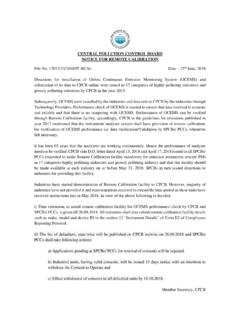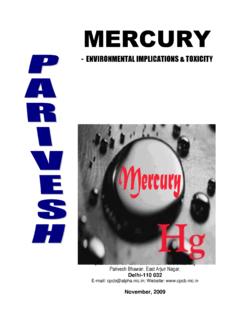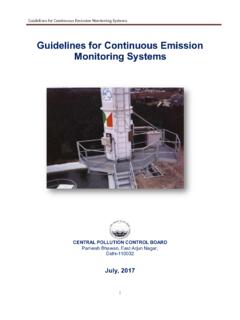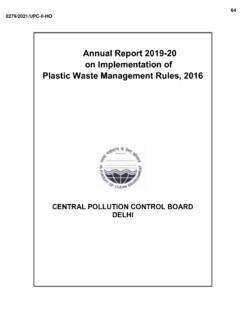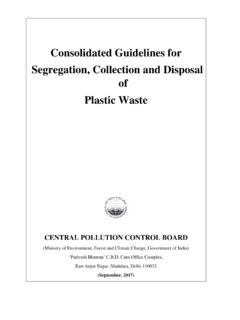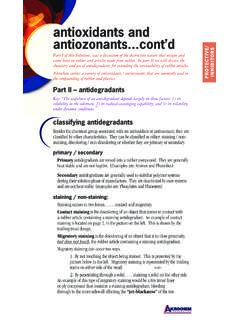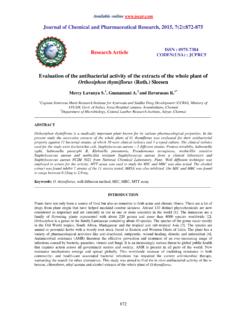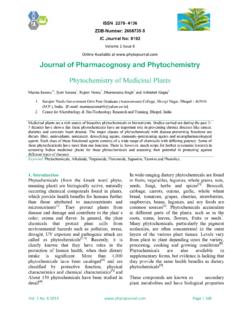Transcription of P PHENOLS & PHENOLIC - Welcome to Central …
1 1 PHENOLS & PHENOLIC COMPOUNDS Central POLLUTION CONTROL BOARD (Ministry of Environment, Forests & Climate Change) PariveshBhawan, East Arjun Nagar Delhi - 110032 website: AUGUST, 2016 PARIVESH 2 FOREWORD PHENOLS or Phenolics are a family of organic compounds characterized by hydroxyl (-OH) group attached to an aromatic ring. Besides serving as generic name for the entire family, the term phenol (C6H5OH) itself is the first member commonly known as benzenol or carbolic acid. All other members in the family are known as derivatives of phenol and PHENOLIC compounds. PHENOLIC compounds are common by-product of any industrial process viz.
2 Manufacture of dyes, plastics, drugs, antioxidants, paper and petroleum industries. PHENOLS and PHENOLIC compounds are widely used in household products and various industries, as intermediates during various industrial synthesis. phenol itself is an established disinfectant in household cleaners. PHENOLS are used as basic material during production of plastics, explosives, drugs, Dye & Dye Intermediate Industries, commercial production of azo dyes etc. PHENOLIC resins form a large part of phenol production. phenol formaldehyde resin was one of the earliest plastic known as Bakelite, which is still in use. Many PHENOLIC compounds occur in nature and used in manufacture of perfumes and artificial flowers because of their pleasant odour and also have wide application in food as antioxidants.
3 Because of wide use of PHENOLS & PHENOLIC compounds, these are discharged alongwith the effluents from several categories of industries such as Textiles, Woolen Mills, Dye & Dye Intermediate Industries, Coke ovens, Pulp & Paper Industries, Iron & Steel Plants, Petrochemicals, Paint Industries, Oil; Drilling & Gas Extraction units; Pharmaceuticals, Coal Washeries, Refractory Industries etc. and enters various environmental matrices. phenol and PHENOLIC compounds cause irritation, odour and taste problem and are toxic in higher concentration. Due to this large number of PHENOLIC compounds are subject to regulations for air and water pollutants around the world.
4 United States Environment Protection Agency (USEPA) has listed eleven PHENOLIC compounds as priority pollutants. In India, the regulatory actions for phenol & PHENOLIC compounds are contemplated under the Environment (Protection) Rules, 1986 under which several environmental standards for discharge of PHENOLS and PHENOLIC compounds in industrial effluent have already been notified. The present issue of Parivesh deals with the chemistry, uses, toxicity, Environmental Implications and Environmental Regulatory Standards of PHENOLS & PHENOLIC Compounds. The issue has been diligently collated and compiled by Dr.
5 Yogita Kharayat, Scientist B ; Sh. V. K. Verma, SSA; Sh. Bhupander Kumar, Scientist `C and Dr. C. S. Sharma, Scientist `E . Hopefully, the information will be useful to all concerned. (S. P. Singh Parihar) IAS Chairman September 1, 2016 3 CONTENT INTRODUCTION PHENOLS AND PHENOLIC COMPOUNDS - TYPES CHEMISTRY AND PHYSICO CHEMICAL PROPERTIES PRODUCTION AND COMMERCIAL USES Production Commercial Uses PHENOLS AND PHENOLIC COMPOUNDS IN THE ENVIRONMENT Natural Sources Anthropogenic Sources DISTRIBUTION AND ENVIRONMENTAL RELEASE EXPOSURE AND EFFECTS ON ENVIRONMENT AND HUMANS TOXICITY OF PHENOLS AND PHENOLIC COMPOUNDS AND MECHANISM OF ACTION MONITORING AND ANALYSIS TECHNIQUES OF PHENOLS IN ENVIRONMENTAL MATRICES REGULATIONS AND ENVIRONMENTAL STANDARDS International Indian Regulations CONTROL MEASURES FOR ABATEMENT OF IMPACT OF PHENOLS AND PHENOLIC
6 COMPOUNDS PROTECTION OF HUMAN HEALTH AND THE ENVIRONMENT REFERENCES / FURTHER READING 4 INTRODUCTION phenol (hydroxybenzene) is a colourless, crystalline substance of characteristic odour, soluble in water and organic solvents. Its common industrial uses including chemical production of alkylphenols, cresols, xylenols, PHENOLIC resins, aniline and other compounds, oil, coal processing and metallurgic. phenol is also used in pesticides, explosives, dyes and textiles production. It is also used as a disinfectant and reagent in chemical analysis. phenol is synthesized on an industrial scale from coal tar.
7 Chemically, phenol is also produced in a reaction between chlorobenzene and sodium hydroxide, toluene oxidation and synthesis from benzene and propylene. Anthropogenic emissions of PHENOLS in the environment are due to the activity of the chemical, pharmaceutical industries, pulp, paper and wood products sector, the mineral (non-metallic) products sector, the steel and metal products sector, and the petroleum refining and products sector. phenol also enters into the environment through vehicle exhaust. The compounds penetrate ecosystems as the result of drainage off the municipal or industrial sewage to surface water.
8 Moreover, the occurrence of PHENOLS in the environment stems from the production and use of numerous pesticides, in particular phenoxy herbicides like acid (2,4-D) or 4-chloro-2- methylphenoxyacetic acid (MCPA) and also PHENOLIC biocides like pentachlorophenol (PCP), dinoseb pesticides. Some PHENOLS may be formed by natural processes such as the formation of phenol and p-cresol (chlorinated PHENOLS ) during decomposition of organic matter. phenol (C6H5OH) - the simplest of the PHENOLS Synonyms for phenol include carbolic acid, benzo- phenol , and hydroxyl benzene. Colorless-to-white solid when pure, however, the commercial product, which contains some water, is a liquid.
9 phenol is a benzene derivative and is the simplest member of the PHENOLIC chemical. The molecule consists of a phenyl (-C6H5), bonded to a hydroxyl (-OH) group. Its chemical formula is C6H5OH. Although they share the same functional group with alcohols, where the OH group is attached to an aliphatic carbon, the chemistry of PHENOLS is very different from that of alcohols. phenol is a colorless-5 to-white solid when pure; however, the commercial product, which contains some water, is a liquid. phenol is a hygroscopic, crystalline solid with characteristic acrid odor and has a sharp burning taste. The odor threshold for phenol is parts per million (ppm), with a strong very sweet odor reported.
10 phenol evaporates more slowly than water, and a moderate amount can form a solution with water. phenol can catch on fire. It is produced on a large scale (about 7 billion kg/year) as a precursor to many materials and useful compounds. phenol is soluble in most organic solvents, its solubility in water is limited at room temperature; above 680C it is entirely water-soluble and is quite flammable. It has a log octanol /water partition coefficient (log Kow) of It is moderately volatile at room temperature. It is weak acid and in its ionized form, very sensitive to electrophile substitution reactions and oxidation.

